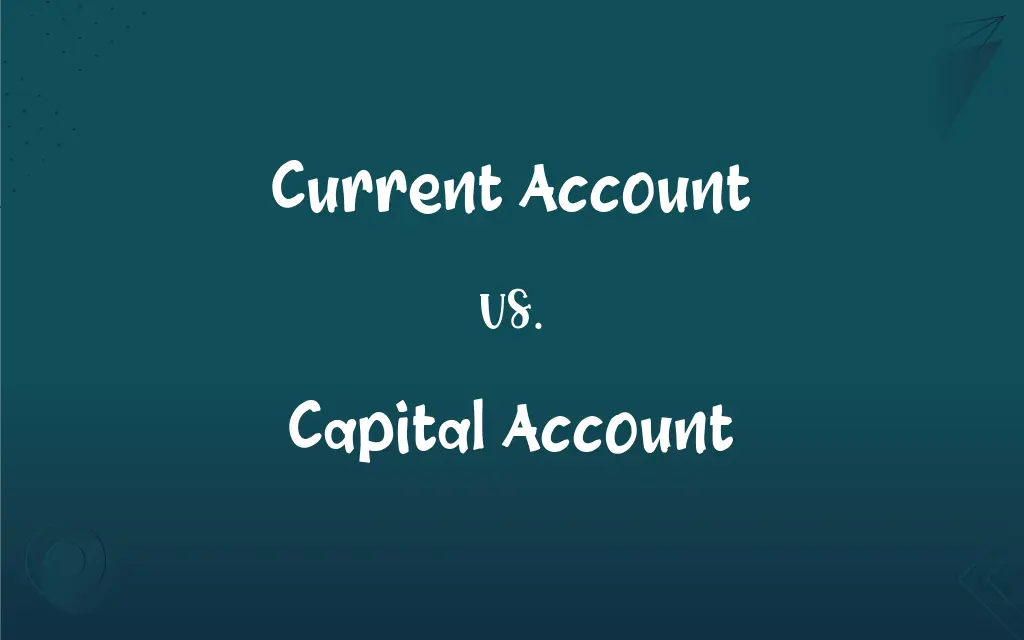Current Account vs. Capital Account: What's the Difference?
Edited by Aimie Carlson || By Janet White || Published on November 28, 2023
The current account records a nation's transactions in goods, services, and income, while the capital account tracks financial and capital asset transfers.

Key Differences
The current account reflects a country's transactions in goods, services, and primary income with the rest of the world, indicating its trade balance and earnings on overseas investments. Conversely, the capital account records the net change in ownership of national assets, encompassing foreign investments and loans.
In the current account, exports and imports of goods and services are primary components, showcasing a nation's economic health and competitiveness. The capital account, however, tracks transactions in financial instruments and changes in foreign investment, reflecting cross-border capital flow.
The current account includes primary income flows from abroad, like wages and dividends, reflecting international income receipts and payments. The capital account details transactions in non-financial and financial assets, such as real estate and securities, signifying international investment dynamics.
A surplus or deficit in the current account directly impacts a nation's net foreign assets, influenced by trade balances and services exchanges. The capital account, by recording investments and loans, offers insights into a country's financial integration and external debt situation.
Current account transactions are more frequent and related to day-to-day economic activities, whereas capital account transactions are less frequent but often involve larger sums, tied to long-term financial commitments and investments.
ADVERTISEMENT
Comparison Chart
Main Components
Goods, services, primary income flows
Capital transfers, acquisition/disposal of non-financial assets
Transaction Types
Trade in goods and services, income receipts/payments
Investments, loans, real estate transactions
Frequency
Frequent, related to daily economic activities
Less frequent, often involving larger sums
Economic Indicator
Trade balance, international income earnings
Financial integration, external debt situation
Balance Impact
Reflects trade competitiveness, net foreign asset change
Shows capital inflows/outflows, investment dynamics
ADVERTISEMENT
Current Account and Capital Account Definitions
Current Account
Reflects a nation's net income from cross-border transactions.
The current account can reveal much about a country's economic health.
Capital Account
Measures international investment flows and ownership changes in assets.
A deficit in the capital account may imply capital outflow.
Current Account
Tracks exports and imports, along with income from investments and work.
A deficit in the current account may suggest a need for economic adjustment.
Capital Account
Records a nation's transactions in financial assets and liabilities.
A high capital account balance can indicate significant foreign investments.
Current Account
A component of the balance of payments, indicating economic interactions.
Fluctuations in the current account can affect currency value.
Capital Account
Tracks cross-border capital transfers and asset transactions.
Changes in the capital account can signal shifts in international investment trends.
Current Account
A record of a country's trade in goods and services, plus income transactions.
A surplus in the current account indicates strong export performance.
Capital Account
A part of the balance of payments, reflecting international asset transfers.
The capital account helps understand a country's external financial position.
Current Account
Measures international trade balance and primary income flows.
The current account balance is closely watched by economists.
Capital Account
Indicates a country's financial integration with the global economy.
The capital account can provide insights into global economic linkages.
FAQs
What does the capital account represent?
It represents a country's transactions in financial and capital assets across borders.
What is a current account?
It's a record of a country's transactions in goods, services, and primary income with other countries.
How does a current account deficit affect a country?
It may indicate that a country is importing more than it exports, potentially leading to economic challenges.
How do current account transactions impact the economy?
They directly reflect a nation's trade balance and earnings from international economic activities.
What is the significance of the capital account in international finance?
It's crucial for understanding a country's financial integration and investment dynamics.
Can a country have a surplus in both accounts?
It's rare, as surpluses in one account are often offset by deficits in the other, due to the balancing nature of international payments.
Can a strong current account lead to economic growth?
Yes, a robust current account can be a sign of a healthy, export-oriented economy.
What does a surplus in the capital account signify?
It often signifies net inbound investments and financial capital, indicating foreign confidence in the economy.
Are current account transactions more frequent than capital account transactions?
Yes, as they involve daily economic activities like trade and income flows.
How does a capital account deficit impact a country's financial status?
It may indicate capital outflows, which can affect a country's creditworthiness and investment appeal.
How do current account transactions relate to everyday economic activities?
They are directly tied to the imports and exports of goods and services and income from abroad.
Are capital account transactions more impactful in terms of value?
Yes, though less frequent, they often involve larger sums and have significant economic implications.
What types of transactions are recorded in the capital account?
Transactions involving foreign investments, loans, and the sale or purchase of assets.
Is the capital account related to long-term economic changes?
Yes, it reflects long-term financial commitments and investments in or out of a country.
How do changes in the current account impact the currency value?
A surplus can strengthen a currency, while a deficit can weaken it, due to changes in foreign exchange demand.
Does the current account include investment income?
Yes, it includes income from foreign investments, like dividends and interest.
What role does the capital account play in a nation's external debt?
It shows how a country finances its debt, either through attracting foreign investments or borrowing.
Can a country control its current and capital account balances?
While governments can influence them through policies, external market forces and global economic conditions also play a major role.
What factors influence the current account balance?
Trade policies, exchange rates, and economic competitiveness are key influencers.
What factors affect the capital account?
Global investment trends, interest rates, and political stability are significant factors.
About Author
Written by
Janet WhiteJanet White has been an esteemed writer and blogger for Difference Wiki. Holding a Master's degree in Science and Medical Journalism from the prestigious Boston University, she has consistently demonstrated her expertise and passion for her field. When she's not immersed in her work, Janet relishes her time exercising, delving into a good book, and cherishing moments with friends and family.
Edited by
Aimie CarlsonAimie Carlson, holding a master's degree in English literature, is a fervent English language enthusiast. She lends her writing talents to Difference Wiki, a prominent website that specializes in comparisons, offering readers insightful analyses that both captivate and inform.






































































